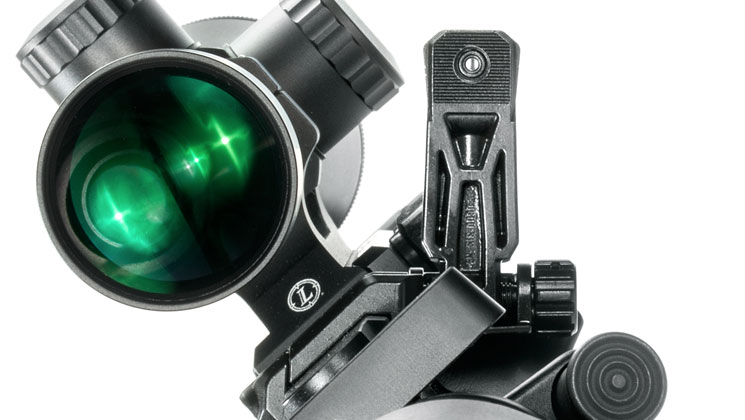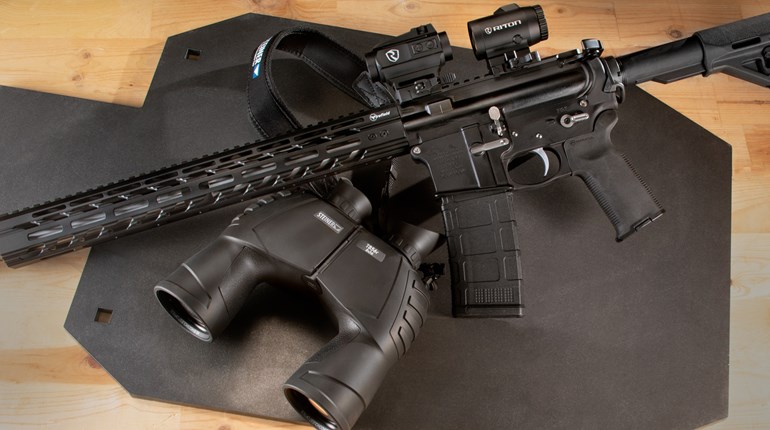
I am one of those guys who is always fidgeting with his guns and gear—never quite content with one setup and always seeking to apply just one more tweak. It’s a habit I picked up in the Army. Whenever I was overseas, I would spend much of the time between missions trying to figure out better ways to carry and get to everything strapped to me in a hurry. This tendency sometimes forces me to make either/or type decisions with regard to the way my rifles are set up, particularly in the case of mounted optics and backup iron sights.
Recently, I came across an extremely well-designed, one-piece scope mount I liked well enough to swap out with the QD mount I have relied on for years. Problem is, the new mount uses traditional hex nuts for attachment to my rifle’s receiver rail and cannot be removed to access backup sights without the use of a wrench. Back when reliable QD scope mounts were not available for our semi-automatic sniper rifles, my teammates and I skinned this cat by keeping multi-tool pliers handy or by taping small wrenches into our pistol grips. The theory being we could remove our scope mounts on the odd chance a scope was damaged beyond use. In certain cases, we eliminated iron sights altogether and used reference points on the rifle to accurately engage man-size targets out to 100 meters. None of these methods were ideal, but we were not exactly flush with better options.
Today’s riflescope-equipped long guns allow backup iron-sight deployment through a number of decent methods. Most modern QD scope mounts will stand up to rugged field use, but they are not exactly fast to employ and often require a small tool (or steel thumb) to pry their levers open. Piggy-back mounts that allow attachment of small red-dot sights are available for scope rings or rail offsets and a small number of tactical optics have crude, short-radius iron sights affixed to their tops. While piggy-back sight systems are quick to employ, they are best used at close range and provide modest accuracy. Fortunately there is an answer for rapidly employable irons that allows you to shoot with accuracy: 45-degree-offset backup iron sights.
I encountered my first offset backup irons almost a decade ago and was not real impressed. These were fixed, and while their utility for 3-gun shooters was obvious—most were using mid-power scopes at that time—I was not smart enough to see these sights’ tactical utility. Eventually I began to install offsets on rifles I built for other shooters and since I also broke-in barrels and zeroed these sights, I had ample opportunity to test the offset concept. I quickly realized I was wrong about them. They are very practical and provide excellent speed and accuracy potential with a little practice.
As their name implies, offset backup iron sights are not in line with the typical sight plane, but are instead mounted on the side of a rifle at a high 45-degree angle, in either a folding or fixed configuration. The rifle must be rotated counter-clockwise (for right-side mounted/right-handed shooters) until the sights are in line with the dominant eye before you can use them. The buttstock and grip will no longer be in their familiar places, but once you get used to the feeling, the position can be attained very naturally. All of the offsets I have used are designed with right-handed shooters in mind, but we southpaws can still partake in the fun. One option for lefties is to mount offsets on the right side and rotate the gun just as a right-handed shooter would, only with less of a stock-to-shoulder footprint and no real cheek contact to speak of. However, I find it easier to mount the sights on the left side of the rifle and rotate it clockwise to bring sights in line with the aiming eye. In this case, the backup irons will be placed backward on the rifle, meaning flip ups will fold forward. Other than ensuring the rear sight does not interfere with the scope mount as it folds forward, I have not had any issues with this configuration.
One thing to remember when shooting prone while using left-side-mounted offsets is that most semi-auto ejection ports will be pointed at the ground. If you are flat and low, it is easy to block ejection and cause a malfunction, which can be fixed by keeping the rifle a few inches off the deck when shooting. Check that right-side-mounted offset BUS have a line-of-sight and are not blocked by the riflescope’s elevation knob. Also, right-side-mounted rear offsets may bump against an AR’s charging handle when folded down (backward). Moving the rear BUS mount forward one or two rail slots will clear the charging handle, which also provides more space for your finger to access the charging handle’s right-side “ear.”
I solved my new scope-mount problem by switching to offset backup irons, choosing Magpul’s MBUS Pro offsets because they’re rugged, small and very affordable when compared to premium-branded offset folding BUS. Mine are mounted backward on the left side of my rifle and work very well. I like them so much that I talked my wife into setting up her .308 Win. AR the same way (albeit right-handed). She found the transition simple and intuitive within just minutes of dry- and live-fire practice. Her slow-fire groups with offset sights are as good as or better than she was getting with traditional, in-line iron sights, which mirrors my own experience.
Offset backup iron sights are a reminder to me that I should never dismiss a new idea just because it does not meet my needs at that time. They are worth a try if you run into real estate problems or need a quick and accurate iron-sight solution for your rifle.




































